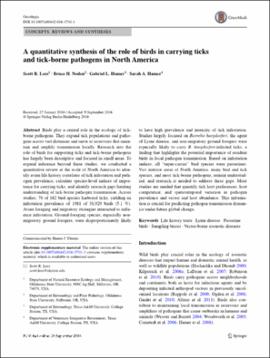| dc.contributor.author | Loss, Scott R. | |
| dc.contributor.author | Noden, Bruce H. | |
| dc.contributor.author | Hamer, Gabriel L. | |
| dc.contributor.author | Hamer, Sarah A. | |
| dc.date.accessioned | 2022-04-12T13:48:04Z | |
| dc.date.available | 2022-04-12T13:48:04Z | |
| dc.date.issued | 2016-09-26 | |
| dc.identifier | oksd_noden_quantitativesynthesis_2016 | |
| dc.identifier.citation | Loss, S. R., Noden, B. H., Hamer, G. L., & Hamer, S. A. (2016). A quantitative synthesis of the role of birds in carrying ticks and tick-borne pathogens in North America. Oecologia, 182(4), pp. 947-959. https://doi.org/10.1007/s00442-016-3731-1 | |
| dc.identifier.uri | https://hdl.handle.net/11244/335164 | |
| dc.description.abstract | Birds play a central role in the ecology of tick-borne pathogens. They expand tick populations and pathogens across vast distances and serve as reservoirs that maintain and amplify transmission locally. Research into the role of birds for supporting ticks and tick-borne pathogens has largely been descriptive and focused in small areas. To expand inference beyond these studies, we conducted a quantitative review at the scale of North America to identify avian life history correlates of tick infestation and pathogen prevalence, calculate species-level indices of importance for carrying ticks, and identify research gaps limiting understanding of tick-borne pathogen transmission. Across studies, 78 of 162 bird species harbored ticks, yielding an infestation prevalence of 1981 of 38,929 birds (5.1�%). Avian foraging and migratory strategies interacted to influence infestation. Ground-foraging species, especially non-migratory ground foragers, were disproportionately likely to have high prevalence and intensity of tick infestation. Studies largely focused on Borrelia burgdorferi, the agent of Lyme disease, and non-migratory ground foragers were especially likely to carry B. burgdorferi-infected ticks, a finding that highlights the potential importance of resident birds in local pathogen transmission. Based on infestation indices, all 'super-carrier' bird species were passerines. Vast interior areas of North America, many bird and tick species, and most tick-borne pathogens, remain understudied, and research is needed to address these gaps. More studies are needed that quantify tick host preferences, host competence, and spatiotemporal variation in pathogen prevalence and vector and host abundance. This information is crucial for predicting pathogen transmission dynamics under future global change. | |
| dc.format | application/pdf | |
| dc.language | en_US | |
| dc.publisher | Springer Science and Business Media LLC | |
| dc.relation.ispartof | Oecologia, 182 (4) | |
| dc.relation.uri | https://www.ncbi.nlm.nih.gov/pubmed/27670413 | |
| dc.rights | This material has been previously published. In the Oklahoma State University Library's institutional repository this version is made available through the open access principles and the terms of agreement/consent between the author(s) and the publisher. The permission policy on the use, reproduction or distribution of the material falls under fair use for educational, scholarship, and research purposes. Contact Digital Resources and Discovery Services at lib-dls@okstate.edu or 405-744-9161 for further information. | |
| dc.subject.mesh | Animals | |
| dc.subject.mesh | Birds | |
| dc.subject.mesh | Borrelia burgdorferi | |
| dc.subject.mesh | Lyme Disease | |
| dc.subject.mesh | Tick Infestations | |
| dc.subject.mesh | Ticks | |
| dc.title | Quantitative synthesis of the role of birds in carrying ticks and tick-borne pathogens in North America | |
| dc.date.updated | 2022-04-07T14:22:54Z | |
| osu.filename | oksd_noden_quantitativesynthesis_2016.pdf | |
| dc.description.peerreview | Peer reviewed | |
| dc.identifier.doi | 10.1007/s00442-016-3731-1 | |
| dc.description.department | Natural Resource Ecology and Management | |
| dc.description.department | Entomology and Plant Pathology | |
| dc.type.genre | Article | |
| dc.type.material | Text | |
| dc.subject.keywords | Life history traits | |
| dc.subject.keywords | Lyme disease | |
| dc.subject.keywords | Passerine birds | |
| dc.subject.keywords | Sampling biases | |
| dc.subject.keywords | Vector-borne zoonotic diseases | |
| dc.subject.keywords | Vector-Borne Diseases | |
| dc.subject.keywords | Infectious Diseases | |
| dc.subject.keywords | Emerging Infectious Diseases | |
| dc.subject.keywords | 2.2 Factors relating to the physical environment | |
| dc.subject.keywords | Infection | |
| dc.subject.keywords | 3 Good Health and Well Being | |
| dc.subject.keywords | 0602 Ecology | |
| dc.subject.keywords | Ecology | |
| dc.identifier.author | ORCID: 0000-0002-8753-2995 (Loss, SR) | |
| dc.identifier.author | ScopusID: 7003720786 (Loss, SR) | |
| dc.identifier.author | ORCID: 0000-0002-0096-370X (Noden, BH) | |
| dc.identifier.author | ScopusID: 6601968347 (Noden, BH) | |
| dc.identifier.author | ScopusID: 14035652100 (Hamer, GL) | |
| dc.identifier.author | ScopusID: 16834375600 (Hamer, SA) | |
